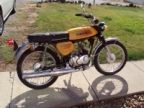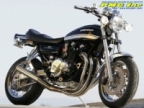Front Brake Troubles
- kaipederson
-
Topic Author
- Offline
- User
- Posts: 10
- Thanks: 0
Front Brake Troubles
13 Dec 2011 01:47
Alright so from the first day i've had my bike, it has been a pain to get rolling by pushing. Just hates to move. So I checked and the rear wheel rolls just fine, but then I notice the front brake will not release from then rotor. It has prevented me from riding the bike as the engine can't fight the brake very well. Bled all the brake fluid but it still won't release. Any ideas? Thanks
Please Log in or Create an account to join the conversation.
- MFolks
-

- Offline
- User
- Posts: 6650
- Thanks: 540
Re: Front Brake Troubles
13 Dec 2011 02:01
Inside the front brake reservoir, are two small holes in the bottom, if one or more is clogged, the brake will not release, acting jut like your problem.
A wooden toothpick(not a metal drill bit) should open up the clog. Changed the brake fluid lately? It's Hydroscopic(absorbs water from the air) and should be changed(I think) once a year.
Brake Fluid Problems
"I like to go with DOT 5 fluid when I rebuild the brakes, just a better product"/quote]
Maybe not better, but certainly different. An alarm went off in my brain, so I Googled this up.
"More than you ever wanted to know about brake fluid....
Brake fluid facts
By Steve Wall
As a former materials engineering supervisor at a major automotive brake system supplier, I feel both qualified and obligated to inject some material science facts into the murky debate about DOT 5 verses DOT 3-4 brake fluids. The important technical issues governing the use of a particular specification brake fluid are as follows:
Fluid compatibility with the brake system rubber, plastic and metal components.
Water absorption and corrosion.
* Fluid boiling point and other physical.
* Brake system contamination and sludging.
Additionally, some technical comments will be made about the new brake fluid formulations appearing on the scene.
First of all, it's important to understand the chemical nature of brake fluid. DOT 3 brake fluids are mixtures of glycols and glycol ethers. DOT4 contains borate esters in addition to what is contained in DOT 3. These brake fluids are somewhat similar to automotive anti-freeze (ethylene glycol) and are not, as Dr. Curve implies, a petroleum fluid. DOT 5 is silicone chemistry .
Fluid Compatibility
Brake system materials must be compatible with the system fluid. Compatibility is determined by chemistry, and no amount of advertising, wishful thinking or rationalizing can change the science of chemical compatibility. Both DOT 3-4 and DOT 5 fluids are compatible with most brake system materials except in the case some silicone rubber external components, such as caliper piston boots, which are attacked by silicon fluids and greases.
Water absorption and corrosion
The big bugaboo with DOT 3-4 fluids always cited by silicone fluid advocates is water absorption. DOT 3-4 glycol based fluids, just like ethylene glycol antifreezes, are readily miscible with water. Long term brake system water content tends to reach a maximum of about 3%, which is readily handled by the corrosion inhibitors in the brake fluid formulation. Since the inhibitors are gradually depleted as. Since the inhibitors are gradually depleted as they do their job, glycol brake fluid, just like anti-freeze, needs to be changed periodically. DOT 5 fluids, not being water miscible, must rely on the silicone (with some corrosion inhibitors) as a barrier film to control corrosion. Water is not absorbed by silicone as in the case of DOT 3-4 fluids, and will remain as a separate globule sinking to the lowest point in the brake system, since it is more dense.
Fluid boiling point
DOT 4 glycol based fluid has a higher boiling point ( 446°F) than DOT 3 ( 446 ºF), and both fluids will exhibit a reduced boiling point as water content increases. DOT 5 in its pure state offers a higher boiling point (500°F) however if water got into the system, and a big globule found its way into a caliper, the water would side at temperatures very much below freezing, let alone at 40° below zero, silicone's low temperature advantage won't be apparent. Neither fluids will reduce stopping distances.
With the advent of ABS systems, the limitations of existing brake fluids have been recognized and the brake fluid manufacturers have been working on formulations with enhanced properties. However, the chosen direction has not been silicone. The only major user of silicone is the US Army. It has recently asked the SAE about a procedure for converting from silicon back to DOT 3-4. If they ever decide to switch, silicone brake fluid will go the way of leaded gas.
Brake system contamination
The single most common brake system failure caused by a contaminant is swelling of the rubber components (piston seals etc.) due to the introduction of petroleum based products (motor oil, power steering fluid, mineral oil etc.) A small amount is enough to do major damage. Flushing with mineral spirits is enough to cause a complete system failure in a short time. I suspect this is what has happened when some car owners changed to DOT 5 (and then assumed that silicone caused the problem). Flushing with alcohol also causes problems. Older brake systems should be flushed only with DOT 3 or 4.
If silicone is introduced into an older brake system, the silicone will latch unto the sludge generated by gradual component deterioration and create a gelatin like goop which will attract more crud and eventually plug up metering orifices or cause pistons to stick. If you have already changed to DOT 5, don't compound your initial mistake and change back. Silicone is very tenacious stuff and you will never get it all out of your system. Just change the fluid regularly. For those who race using silicone fluid, I recommend that you crack the bleed screws before each racing session to insure that there is no water in the calipers.
New developments
Since DOT 4 fluids were developed, it was recognized that borate ester based fluids offered the potential for boiling points beyond the 446°F requirement, thus came the Super DOT 4 fluids - some covered by the DOT 5.1 designation -which exhibit a minimum dry boiling point of 500°F (same as silicone, but different chemistry).
Additionally, a new fluid type based on silicon ester chemistry (not the same as silicon) has been developed that exhibits a minimum dry boiling point of 590°F. It is miscible with DOT 3-4 fluds but has yet to see commercial usage." I learned in the past thru others mistakes not to switch to DOT 5 in systems designed for DOT 3 or 4.
Brake System Bed-in Theory, Definitions & Procedures
StopTech's Recommended Procedure for Bedding-in Performance Brake Systems
by Matt Weiss of StopTech and James Walker, Jr. of scR motorsports
When a system has both new rotors and pads, there are two different objectives for bedding-in a performance brake system: heating up the brake rotors and pads in a prescribed manner, so as to transfer pad material evenly onto the rotors; and maturing the pad material, so that resins which are used to bind and form it are ‘cooked' out of the pad.
The first objective is achieved by performing a series of stops, so that the brake rotor and pad material are heated steadily to a temperature that promotes the transfer of pad material onto the brake rotor friction surface. There is one pitfall in this process, however, which must be avoided. The rotor and, therefore, the vehicle should not be brought to a complete stop, with the brakes still applied, as this risks the non-uniform transfer of pad material onto the friction surface.
The second objective of the bedding-in process is achieved by performing another set of stops, in order to mature the pad itself. This ensures that resins which are used to bind and form the pad material are ‘cooked' out of the pad, at the point where the pad meets the rotor's friction surface.
The bed-in process is not complete until both sets of stops have been performed. There's one exception, however. Some pad manufacturers sell ‘race-ready' pads, which have been pre-conditioned by flame heat-treating or laser etching, to provide a mature surface on the pad face. If race-ready pads are being used, then the second set of controlled stops is unnecessary. Also note that the same circumstances exist when a system to be bedded has new rotors and used pads (a strategy that professional teams use to break in their rotors ahead of time) one only has to perform a single set of stops to transfer pad material uniformly onto the new rotor.
Note that, if the brakes of a vehicle with high-performance or racing pads are not used continuously in an aggressive manner, the transfer layer on the rotors can be abraded (literally worn off). However, the transfer layer can be re-established, if needed, by repeating one series of stops in the bed-in procedure. This process may be repeated as often as necessary during the life of the pad.
This characteristic is useful when a system is already bedded-in with one pad friction and another is to be used going forward, like when changing between pad types for the street and track (and then after a track event, back again). The procedure under this case is different, where the new friction is installed and the vehicle is first driven for 5 to 20 miles (8 to 33 Km) with light use, keeping the pad friction and rotor cold. This promotes the abrasive friction mechanism cleaning the rotor surface of the previous pad material before performing either one or two bed-in cycles as prescribed below. One set of stops as outlined, if the pads being installed are used, two if the pads are actually new
The bed-in procedures below outline the steps required to effectively bed-in performance brake systems. We strongly recommend that, in order to complete the bed-in safely, the bed-in procedures be conducted in dry conditions on a race track or other controlled environment, so as not to endanger yourself or others. Please note that we neither recommend nor condone driving at high speeds on public roads. While it is important to get enough heat into the system to effectively bed-in the brakes, it is even more important to exercise common sense at all times, and to conduct the bed-in procedure responsibly.
Bedding-in Street-Performance Pads
For a typical performance brake system using street-performance pads, a series of ten partial braking events, from 60mph down to 10mph, will typically raise the temperature of the brake components sufficiently to be considered one bed-in set. Each of the ten partial braking events should achieve moderate-to-high deceleration (about 80 to 90% of the deceleration required to lock up the brakes and/or to engage the ABS), and they should be made one after the other, without allowing the brakes to cool in between.
Depending on the make-up of the pad material, the brake friction will seem to gain slightly in performance, and will then lose or fade somewhat by around the fifth stop (also about the time that a friction smell will be detectable in the passenger compartment). This does not indicate that the brakes are bedded-in. This phenomenon is known as a green fade, as it is characteristic of immature or ‘green' pads, in which the resins still need to be driven out of the pad material, at the point where the pads meet the rotors. In this circumstance, the upper temperature limit of the friction material will not yet have been reached.
As when bedding-in any set of brakes, care should be taken regarding the longer stopping distance necessary with incompletely bedded pads. This first set of stops in the bed-in process is only complete when all ten stops have been performed - not before. The system should then be allowed to cool, by driving the vehicle at the highest safe speed for the circumstances, without bringing it to a complete stop with the brakes still applied. After cooling the vehicle, a second set of ten partial braking events should be performed, followed by another cooling exercise. In some situations, a third set is beneficial, but two are normally sufficient.
A wooden toothpick(not a metal drill bit) should open up the clog. Changed the brake fluid lately? It's Hydroscopic(absorbs water from the air) and should be changed(I think) once a year.
Brake Fluid Problems
"I like to go with DOT 5 fluid when I rebuild the brakes, just a better product"/quote]
Maybe not better, but certainly different. An alarm went off in my brain, so I Googled this up.
"More than you ever wanted to know about brake fluid....
Brake fluid facts
By Steve Wall
As a former materials engineering supervisor at a major automotive brake system supplier, I feel both qualified and obligated to inject some material science facts into the murky debate about DOT 5 verses DOT 3-4 brake fluids. The important technical issues governing the use of a particular specification brake fluid are as follows:
Fluid compatibility with the brake system rubber, plastic and metal components.
Water absorption and corrosion.
* Fluid boiling point and other physical.
* Brake system contamination and sludging.
Additionally, some technical comments will be made about the new brake fluid formulations appearing on the scene.
First of all, it's important to understand the chemical nature of brake fluid. DOT 3 brake fluids are mixtures of glycols and glycol ethers. DOT4 contains borate esters in addition to what is contained in DOT 3. These brake fluids are somewhat similar to automotive anti-freeze (ethylene glycol) and are not, as Dr. Curve implies, a petroleum fluid. DOT 5 is silicone chemistry .
Fluid Compatibility
Brake system materials must be compatible with the system fluid. Compatibility is determined by chemistry, and no amount of advertising, wishful thinking or rationalizing can change the science of chemical compatibility. Both DOT 3-4 and DOT 5 fluids are compatible with most brake system materials except in the case some silicone rubber external components, such as caliper piston boots, which are attacked by silicon fluids and greases.
Water absorption and corrosion
The big bugaboo with DOT 3-4 fluids always cited by silicone fluid advocates is water absorption. DOT 3-4 glycol based fluids, just like ethylene glycol antifreezes, are readily miscible with water. Long term brake system water content tends to reach a maximum of about 3%, which is readily handled by the corrosion inhibitors in the brake fluid formulation. Since the inhibitors are gradually depleted as. Since the inhibitors are gradually depleted as they do their job, glycol brake fluid, just like anti-freeze, needs to be changed periodically. DOT 5 fluids, not being water miscible, must rely on the silicone (with some corrosion inhibitors) as a barrier film to control corrosion. Water is not absorbed by silicone as in the case of DOT 3-4 fluids, and will remain as a separate globule sinking to the lowest point in the brake system, since it is more dense.
Fluid boiling point
DOT 4 glycol based fluid has a higher boiling point ( 446°F) than DOT 3 ( 446 ºF), and both fluids will exhibit a reduced boiling point as water content increases. DOT 5 in its pure state offers a higher boiling point (500°F) however if water got into the system, and a big globule found its way into a caliper, the water would side at temperatures very much below freezing, let alone at 40° below zero, silicone's low temperature advantage won't be apparent. Neither fluids will reduce stopping distances.
With the advent of ABS systems, the limitations of existing brake fluids have been recognized and the brake fluid manufacturers have been working on formulations with enhanced properties. However, the chosen direction has not been silicone. The only major user of silicone is the US Army. It has recently asked the SAE about a procedure for converting from silicon back to DOT 3-4. If they ever decide to switch, silicone brake fluid will go the way of leaded gas.
Brake system contamination
The single most common brake system failure caused by a contaminant is swelling of the rubber components (piston seals etc.) due to the introduction of petroleum based products (motor oil, power steering fluid, mineral oil etc.) A small amount is enough to do major damage. Flushing with mineral spirits is enough to cause a complete system failure in a short time. I suspect this is what has happened when some car owners changed to DOT 5 (and then assumed that silicone caused the problem). Flushing with alcohol also causes problems. Older brake systems should be flushed only with DOT 3 or 4.
If silicone is introduced into an older brake system, the silicone will latch unto the sludge generated by gradual component deterioration and create a gelatin like goop which will attract more crud and eventually plug up metering orifices or cause pistons to stick. If you have already changed to DOT 5, don't compound your initial mistake and change back. Silicone is very tenacious stuff and you will never get it all out of your system. Just change the fluid regularly. For those who race using silicone fluid, I recommend that you crack the bleed screws before each racing session to insure that there is no water in the calipers.
New developments
Since DOT 4 fluids were developed, it was recognized that borate ester based fluids offered the potential for boiling points beyond the 446°F requirement, thus came the Super DOT 4 fluids - some covered by the DOT 5.1 designation -which exhibit a minimum dry boiling point of 500°F (same as silicone, but different chemistry).
Additionally, a new fluid type based on silicon ester chemistry (not the same as silicon) has been developed that exhibits a minimum dry boiling point of 590°F. It is miscible with DOT 3-4 fluds but has yet to see commercial usage." I learned in the past thru others mistakes not to switch to DOT 5 in systems designed for DOT 3 or 4.
Brake System Bed-in Theory, Definitions & Procedures
StopTech's Recommended Procedure for Bedding-in Performance Brake Systems
by Matt Weiss of StopTech and James Walker, Jr. of scR motorsports
When a system has both new rotors and pads, there are two different objectives for bedding-in a performance brake system: heating up the brake rotors and pads in a prescribed manner, so as to transfer pad material evenly onto the rotors; and maturing the pad material, so that resins which are used to bind and form it are ‘cooked' out of the pad.
The first objective is achieved by performing a series of stops, so that the brake rotor and pad material are heated steadily to a temperature that promotes the transfer of pad material onto the brake rotor friction surface. There is one pitfall in this process, however, which must be avoided. The rotor and, therefore, the vehicle should not be brought to a complete stop, with the brakes still applied, as this risks the non-uniform transfer of pad material onto the friction surface.
The second objective of the bedding-in process is achieved by performing another set of stops, in order to mature the pad itself. This ensures that resins which are used to bind and form the pad material are ‘cooked' out of the pad, at the point where the pad meets the rotor's friction surface.
The bed-in process is not complete until both sets of stops have been performed. There's one exception, however. Some pad manufacturers sell ‘race-ready' pads, which have been pre-conditioned by flame heat-treating or laser etching, to provide a mature surface on the pad face. If race-ready pads are being used, then the second set of controlled stops is unnecessary. Also note that the same circumstances exist when a system to be bedded has new rotors and used pads (a strategy that professional teams use to break in their rotors ahead of time) one only has to perform a single set of stops to transfer pad material uniformly onto the new rotor.
Note that, if the brakes of a vehicle with high-performance or racing pads are not used continuously in an aggressive manner, the transfer layer on the rotors can be abraded (literally worn off). However, the transfer layer can be re-established, if needed, by repeating one series of stops in the bed-in procedure. This process may be repeated as often as necessary during the life of the pad.
This characteristic is useful when a system is already bedded-in with one pad friction and another is to be used going forward, like when changing between pad types for the street and track (and then after a track event, back again). The procedure under this case is different, where the new friction is installed and the vehicle is first driven for 5 to 20 miles (8 to 33 Km) with light use, keeping the pad friction and rotor cold. This promotes the abrasive friction mechanism cleaning the rotor surface of the previous pad material before performing either one or two bed-in cycles as prescribed below. One set of stops as outlined, if the pads being installed are used, two if the pads are actually new
The bed-in procedures below outline the steps required to effectively bed-in performance brake systems. We strongly recommend that, in order to complete the bed-in safely, the bed-in procedures be conducted in dry conditions on a race track or other controlled environment, so as not to endanger yourself or others. Please note that we neither recommend nor condone driving at high speeds on public roads. While it is important to get enough heat into the system to effectively bed-in the brakes, it is even more important to exercise common sense at all times, and to conduct the bed-in procedure responsibly.
Bedding-in Street-Performance Pads
For a typical performance brake system using street-performance pads, a series of ten partial braking events, from 60mph down to 10mph, will typically raise the temperature of the brake components sufficiently to be considered one bed-in set. Each of the ten partial braking events should achieve moderate-to-high deceleration (about 80 to 90% of the deceleration required to lock up the brakes and/or to engage the ABS), and they should be made one after the other, without allowing the brakes to cool in between.
Depending on the make-up of the pad material, the brake friction will seem to gain slightly in performance, and will then lose or fade somewhat by around the fifth stop (also about the time that a friction smell will be detectable in the passenger compartment). This does not indicate that the brakes are bedded-in. This phenomenon is known as a green fade, as it is characteristic of immature or ‘green' pads, in which the resins still need to be driven out of the pad material, at the point where the pads meet the rotors. In this circumstance, the upper temperature limit of the friction material will not yet have been reached.
As when bedding-in any set of brakes, care should be taken regarding the longer stopping distance necessary with incompletely bedded pads. This first set of stops in the bed-in process is only complete when all ten stops have been performed - not before. The system should then be allowed to cool, by driving the vehicle at the highest safe speed for the circumstances, without bringing it to a complete stop with the brakes still applied. After cooling the vehicle, a second set of ten partial braking events should be performed, followed by another cooling exercise. In some situations, a third set is beneficial, but two are normally sufficient.
1982 GPZ1100 B2
General Dynamics/Convair 1983-1993
GLCM BGM-109 Tomahawk, AGM-129A Advanced Cruise Missile (ACM)
General Dynamics/Convair 1983-1993
GLCM BGM-109 Tomahawk, AGM-129A Advanced Cruise Missile (ACM)
Please Log in or Create an account to join the conversation.
- martin_csr
-

- Offline
- User
- Posts: 8019
- Thanks: 1645
Last edit: 19 Feb 2013 13:13 by martin_csr.
Please Log in or Create an account to join the conversation.
- donthekawguy
-

- Offline
- User
- Posts: 1913
- Thanks: 8
Re: Front Brake Troubles
14 Dec 2011 01:24
Take the caliper off, get the piston out and check the grove the the seal sits in. they tend to clog up and hold the piston out. Clean out the groove with a wire wheel on a dremmel. Clean it up and you should be good.
Rathdrum Idaho
1971 Kawasaki g3ss
1972 Yamaha R5 350
1965 Suzuki Hillbilly
1964 Yamaha 125
1971 Kawasaki g3ss
1972 Yamaha R5 350
1965 Suzuki Hillbilly
1964 Yamaha 125
Please Log in or Create an account to join the conversation.
- Juan1
-
- Offline
- User
- Posts: 37
- Thanks: 0
Re: Front Brake Troubles
14 Dec 2011 14:48
It is likely a caliper or caliper piston issue. To be sure, bled the front brake first. If you are getting a strong stream from both bleed holes, it is a caliper issue. Unbolt them and pry them off the rotor. Remove the caliper piston and make sure the piston housing is corrosion free. Sand if needed. Do the same with the piston.
Please Log in or Create an account to join the conversation.
- turboguzzi
-

- Offline
- User
- Posts: 839
- Thanks: 72
Re: Front Brake Troubles
21 Dec 2011 11:38Juan1 wrote: It is likely a caliper or caliper piston issue. To be sure, bled the front brake first. If you are getting a strong stream from both bleed holes, it is a caliper issue. Unbolt them and pry them off the rotor. Remove the caliper piston and make sure the piston housing is corrosion free. Sand if needed. Do the same with the piston.
nice how you became an expert so quick
merry christmas
TG
Please Log in or Create an account to join the conversation.
- redneckcarrow
-

- Offline
- User
- Posts: 49
- Thanks: 1
Re: Front Brake Troubles
21 Dec 2011 23:42
mine does the same thing havent fixed yet bike up for winter mine is the master cylender. try to push the bike if pushes hard start at the master cylender and crack open the brakeline fitting then try pushing bike again if freed up the fluid isnt going make in master and is keeping slit press on brakes if that doesnt work just work your way down to the calipers till it frees up that will tell you what might be pluged up if you get all the way down to calipers then piston is prob sticking
1980 kz 550 ltd stock
Please Log in or Create an account to join the conversation.
- Fritula
-

- Offline
- User
- holly land garage
- Posts: 46
- Thanks: 0
Re: Front Brake Troubles
22 Dec 2011 05:06
If you are already OVERDUE with your brakes maintenance,there is not much to say.The way you are opening one by one caliper or/and master you will find it easy. Expense is very the same.
Please Log in or Create an account to join the conversation.
